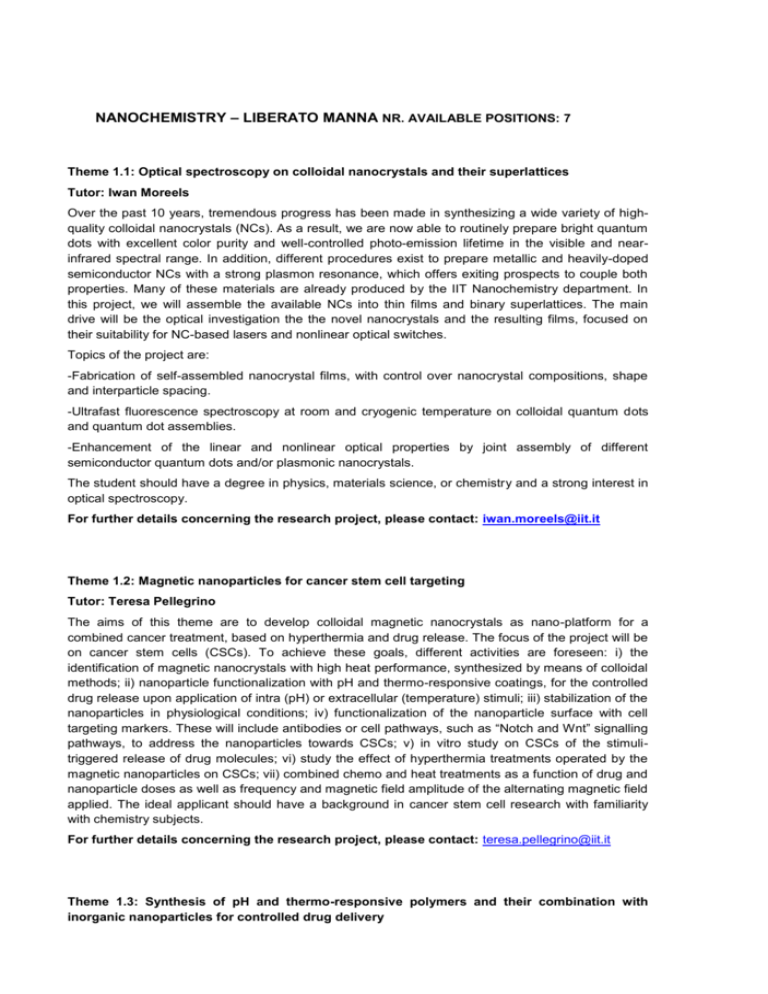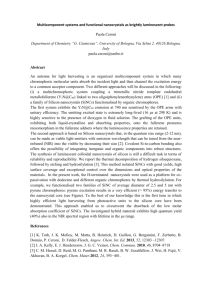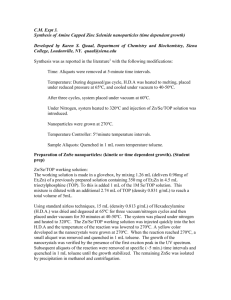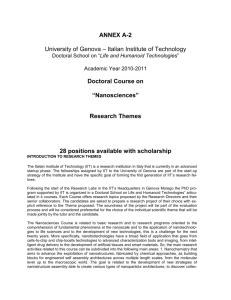Microsoft Word - ANNEX-A4 DEF
advertisement

NANOCHEMISTRY – LIBERATO MANNA NR. AVAILABLE POSITIONS: 7 Theme 1.1: Optical spectroscopy on colloidal nanocrystals and their superlattices Tutor: Iwan Moreels Over the past 10 years, tremendous progress has been made in synthesizing a wide variety of highquality colloidal nanocrystals (NCs). As a result, we are now able to routinely prepare bright quantum dots with excellent color purity and well-controlled photo-emission lifetime in the visible and nearinfrared spectral range. In addition, different procedures exist to prepare metallic and heavily-doped semiconductor NCs with a strong plasmon resonance, which offers exiting prospects to couple both properties. Many of these materials are already produced by the IIT Nanochemistry department. In this project, we will assemble the available NCs into thin films and binary superlattices. The main drive will be the optical investigation the the novel nanocrystals and the resulting films, focused on their suitability for NC-based lasers and nonlinear optical switches. Topics of the project are: -Fabrication of self-assembled nanocrystal films, with control over nanocrystal compositions, shape and interparticle spacing. -Ultrafast fluorescence spectroscopy at room and cryogenic temperature on colloidal quantum dots and quantum dot assemblies. -Enhancement of the linear and nonlinear optical properties by joint assembly of different semiconductor quantum dots and/or plasmonic nanocrystals. The student should have a degree in physics, materials science, or chemistry and a strong interest in optical spectroscopy. For further details concerning the research project, please contact: iwan.moreels@iit.it Theme 1.2: Magnetic nanoparticles for cancer stem cell targeting Tutor: Teresa Pellegrino The aims of this theme are to develop colloidal magnetic nanocrystals as nano-platform for a combined cancer treatment, based on hyperthermia and drug release. The focus of the project will be on cancer stem cells (CSCs). To achieve these goals, different activities are foreseen: i) the identification of magnetic nanocrystals with high heat performance, synthesized by means of colloidal methods; ii) nanoparticle functionalization with pH and thermo-responsive coatings, for the controlled drug release upon application of intra (pH) or extracellular (temperature) stimuli; iii) stabilization of the nanoparticles in physiological conditions; iv) functionalization of the nanoparticle surface with cell targeting markers. These will include antibodies or cell pathways, such as “Notch and Wnt” signalling pathways, to address the nanoparticles towards CSCs; v) in vitro study on CSCs of the stimulitriggered release of drug molecules; vi) study the effect of hyperthermia treatments operated by the magnetic nanoparticles on CSCs; vii) combined chemo and heat treatments as a function of drug and nanoparticle doses as well as frequency and magnetic field amplitude of the alternating magnetic field applied. The ideal applicant should have a background in cancer stem cell research with familiarity with chemistry subjects. For further details concerning the research project, please contact: teresa.pellegrino@iit.it Theme 1.3: Synthesis of pH and thermo-responsive polymers and their combination with inorganic nanoparticles for controlled drug delivery Tutor: Teresa Pellegrino In current anticancer chemotherapies a critical drawback is related to the drugs being delivered not only to malignant cells. Existing treatments could be by far more efficient if the drugs could be delivered selectively to the tumour site under defined stimuli. pH AND TERMOSENSITIVE HYDROGELS are polymeric nano-beads that are able to undergo volume changes and thus drug incorporation and release under the effect of physical and chemical stimuli like heat or pH. The present PhD project will focus on the development of pH and thermo responsive polymers which can act as nanocontainers for encapsulation, protection, and transport of chemotherapeutic agents. Also, the inclusion of magnetic nanoparticles within the hydrogel will add two additional advantages: it will facilitate the delivery under a magnetic field to a tumour site and at the same time, it will act as a hyperthermia agent to heat locally the nanostructure and trigger the drug release. The candidate should work on the preparation of pH AND TERMOSENSITIVE HYDROGELS with a control over the size, shape, composition biodegradability and physical properties. In addition, the combination of the polymeric nanocontainers with magnetic nanoparticles will be a key step in the fabrication of nanostructures able to elicit combined hyperthermia and drug release. The payload, being a drug or a short oligonucleotide sequence, will be encapsulated within the polymeric shell by tuning pH and/or temperature of the medium and, as such, the swelling properties. For further details concerning the research project, please contact: teresa.pellegrino@iit.it Theme 1.4: Experimental and modeling aspects of (S)TEM imaging and EEL spectroscopy of complex semiconductor and oxide nanostructures Tutors: Giovanni Bertoni, Rosaria Brescia High resolution transmission electron microscopy, both in parallel and in convergent beam configurations (TEM and STEM, respectively), is able to provide a wealth of information concerning the structural properties of materials. In addition to the highly spatially resolved qualitative information, quantitative structural determination can be obtained from the interpretation of images based on modeling and simulations. This information can be coupled to the analysis of the energy distribution of electrons after inelastic interaction with the sample via electron energy-loss spectroscopy (EELS). The latter technique, in particular carried out at the element ionization edges, is able to provide valuable insights concerning the local structural, chemical, and electronic properties of individual elements at sub-nanometer resolution. The experimental results, in combination with modeling (e.g., density functional theory, multiple scattering theory), are able to shed light on a variety of aspects (e.g., oxidation state or valence, local chemical environment) which are useful to understand the material properties. In particular, nanostructured systems with a broad variety of compositions, sizes and morphologies, mostly synthesized by chemical methods, offer an interesting field of investigation due to their tunable optical, electronic, and chemical and magnetic properties. The aim of this project is the model-based quantitative analysis of the structural and electronic properties of these systems, as-fabricated and after employment within chemical (e.g., ligand exchange, catalysis for CO abatement) and electrochemical (e.g., lithium-ion batteries) processes, which will provide helpful complementary information concerning the ongoing phenomena. For further details concerning the research project, please contact: Giovanni.bertoni@iit.it, rosaria.brescia@iit.it Theme 1.5: Novel catalytic materials based on nanocomposites for water gas shift reaction and selective carbon monoxide oxidation Tutors: Massimo Colombo, Liberato Manna The aim of this theme is to develop new catalysts for CO abatement in hydrogen-rich gases for fuel cells, produced through steam reforming of fossil fuels, alcohols or biomass. In polymer electrolyte fuel cells, due to their low operational temperature, the platinum catalyst is likely to be poisoned by carbon monoxide (CO), and the performance of the unit is degraded when CO is present in the reformed gas beyond a few ppm. In general, a CO removal unit is provided downstream a reforming unit which produces the reformed gas rich in hydrogen, and CO is selectively converted and removed through a series of reactions (water gas shift and, e.g., selective carbon monoxide oxidation) in order to obtain a CO concentration in the reformed gas <10 ppm. Typical catalysts for CO conversion are based on Cu-Zn, CeO2-Au, and Fe3O4-Au. The aims here are to prepare new composite materials made of metal oxide nanocrystals/metal domains. These composite are expected to exhibit catalytic properties towards the water gas shift reaction and preferential CO oxidation. The steps involved will be: (a) Synthesis of various metal-metal oxide (MO) based nanostructures (by employing both nonhydrolytic and hydrolytic methods). (b) Assembly of these A-MO heterostructures to form composite materials. (c) Catalytic tests and catalyst characterization. The ideal applicant should have a background in chemistry or chemical engineering with familiarity with catalysis. For further details concerning the research project, please contact: liberato.manna@iit.it; massimo.colombo@iit.it Theme 1.6: Nanoparticles for energy storage applications Tutor: Liberato Manna, Luca De Trizio The aim of this research theme is to develop nanocrystals based composite materials for energy storage application. The emphasis will be on lithium ion battery applications, for which one key step is to identify novel candidate nanoscale materials for the electrodes. The focus will be mainly on nanoscale layered materials, such as transition metal dichalcogenides and layered metal oxides, which are capable of hosting lithium in between the layers. We will develop colloidal synthesis approaches for these compounds, which will be first of all studied in detail for what concerns their optical, structural, electronic and electrical transport properties. In addition, electrochemical studies will be carried out at every stage of the project, starting from the as-prepared nanocrystals up to the final battery assembly. The successful candidate for this theme should have a strong background in disciplines such as Materials Science, Chemistry or Chemical Engineering. For further details concerning the research project, please contact: liberato.manna@iit.it; luca.detrizio@iit.it Theme 1.7: Study of the chemical transformations in nanocrystals for applications in plasmonics and photovoltaics Tutor: Liberato Manna, Yi Xie The aim of this research theme is to study chemical transformations in nanocrystals in order to prepare nanoscale materials with finely tuned properties, for applications in both plasmonics and photovoltaics. One example is represented by cation exchange reactions, which involve partial or complete replacement of the sublattice of cations in a crystal with a new sublattice of different cations, while the sublattice of anions remains in place. Another example is represented by oxidation/ reduction processes which can alter the chemical composition of a nanocrystal, which in turn will impact its electronic properties. It is possible to exploit these reactions and their combination, to access nanocrystals of materials that are difficult to prepare via direct synthesis or for which these reactions provide a means for fine tuning of the chemical composition. Two main classes of compounds will be studied: binary copper chalcogenide nanocrystals, in which the copper stoichiometry regulates their plasmonic behavior, and ternary and quaternary semiconductor nanocrystals, in which the relative stoichiometric ratios of the various cations in the lattice regulate the band gap of the material. The project involves the colloidal synthesis of nanocrystals, the study of their transformations by means of various techniques (spectroscopy, electrochemistry, electron microscopy with all its ancillary in-situ techniques, X-ray diffraction), and the study of the properties of the final particles. For plasmonic materials, this will include the identification of the active plasmonic modes, the study of the plasmon dynamics and the investigation of the near field properties. For photovoltaic materials, this will include the analysis of their optical and transport properties (both in the dark and under illumination) and their testing as active materials in prototype photovoltaic devices. To this aim, the project foresees the development of procedures to exchange the native surfactant stabilizers with carbon-free ligands, with the aim of having final nanocrystal-based cells characterized by high power conversion efficiency. For further details concerning the research project, please contact: liberato.manna@iit.it; yi.xie@iit.it






